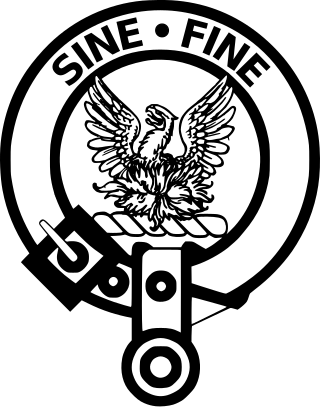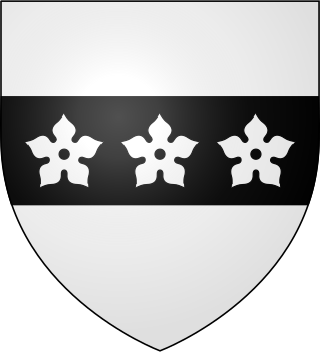
Murdoch Stewart, Duke of Albany was a leading Scottish nobleman, the son of Robert Stewart, Duke of Albany, and the grandson of King Robert II of Scotland, who founded the Stewart dynasty. In 1389, he became Justiciar North of the Forth. In 1402, he was captured at the Battle of Homildon Hill and would spend 12 years in captivity in England.

Clan Anstruther is a Scottish clan.

Clan Douglas is an ancient clan or noble house from the Scottish Lowlands.

Clan Napier is a Lowland Scottish clan.

Clan Cathcart is a Lowland Scottish clan.

Clan Charteris is a Scottish clan of the Scottish Lowlands.

Clan Colville is a Lowland Scottish clan.

Clan Lumsden is a Border Scottish clan.
Spencer is a surname, representing the court title dispenser, or steward. An early example is Robert d'Abbetot, who is listed as Robert le Dispenser, a tenant-in-chief of several counties, in the Domesday Book of 1086. In early times, the surname was usually written as le Despenser, Dispenser or Despencer—notably in works such as the Domesday Book and the Scottish Ragman Rolls of 1291 and 1296, but gradually lost both the "le" article and the unstressed first syllable of the longer surname to become Spencer.

Clan Moncreiffe is a Highland Scottish clan.

Clan Oliphant is a Highland Scottish clan.
William Patrick Spens, 1st Baron Spens, KBE, PC, KC was a British lawyer, judge and Conservative politician. He served as Chief Justice of India from 1943 to 1947.

Clan Haldane is a Lowland Scottish clan.

Clan Swinton is a Scottish clan of the Scottish Lowlands.

Clan Makgill is a Lowland Scottish clan.

Clan Boswell is a Lowland Scottish clan and is recognized as such by the Lord Lyon King of Arms. However the clan does not currently have a chief and is therefore considered an Armigerous clan.

Clan Forbes is a Highland Scottish clan from Aberdeenshire, Scotland.

Nathaniel Spens was a Scottish medical doctor who qualified as Fellow of the Incorporation of Surgeons and then became increasingly interested in the practice of physic. He qualified as a Fellow of the Royal College of Physicians of Edinburgh and went on to become President of that College.

William Inglis was a Scottish surgeon who had the unique distinction of serving as Deacon of the Incorporation of Surgeons of Edinburgh and then serving two further terms as President of the Royal College of Surgeons of the City of Edinburgh, as the organisation became known after receiving a Royal Charter in 1778. He was one of the earliest captains of the Honourable Company of Edinburgh Golfers.
Dr Thomas SpensPRCPE FRSE (1764–1842) was an 18th/19th century Scottish physician who served as President of the Royal College of Physicians of Edinburgh from 1803 to 1806.

















